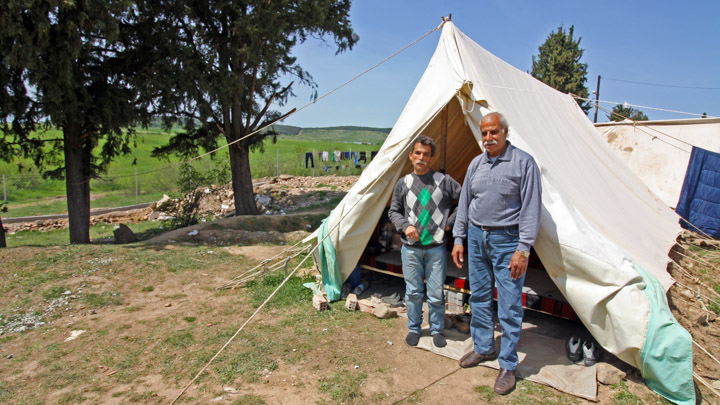
Atallah Taba watched his wife die after a bomb ripped apart their home outside of Damascus, Syria. Instantly, the 74-year-old lost everything he worked for his whole life. Still grieving for the loss of his partner and the mother of their six children, Atallah made the painful decision to flee his home, clinging onto a few precious family photos and his smartphone. He traveled on foot for weeks, across hundreds of miles, towards Turkey before he was captured by the Turkish army. Exhausted, Taba told them, “Kill me, but don’t send me back to Syria.”
Taba’s story is heartbreaking and it’s even more devastating to think that there are millions of men, women and children who have endured similar hardships. According to the U.N. High Commissioner for Refugees, worldwide there are 65 million people who have been forcibly displaced from their homes, of whom about one in three are refugees escaping from conflict and persecution. The scale and complexity of the worldwide refugee crisis, including 4.8 million Syrian refugees, is overwhelming.
Today on World Refugee Day, we recognize the strength, bravery and resilience of refugees. And we share our gratitude for those who, amidst all the despair, are working so hard to bring hope to these people. Taba eventually made it safely to the Cherso refugee camp in Greece. He and many others are being assisted by organizations like our nonprofit partners that are dedicated to helping refugees survive, recover and rebuild their lives.
I met with our nonprofit partners and U.N. representatives earlier this year when I traveled to Jordan’s Zaatari refugee camp, where thousands of U.N. tents form a makeshift desert city of over 75,000 people. I saw how, every day, our nonprofit partners overcome incalculable challenges to deliver shelter, food, medical aid and other critical services to people who have had their homes, jobs, loved ones and dreams ripped away from them. We had many conversations about how technology has essentially become a new form of aid as it enables communication between refugees and their families, coordination within and between aid agencies, access to information about migration routes, and the rebuilding of refugees’ lives.
I heard many stories about the profound impact that technology has made on refugees and the agencies supporting them. When our partner NetHope installed Wi-Fi at the Cherso camp, Taba was finally able to contact his daughter after two long years of separation. Before that, he had no way to reach her to tell her he was alive and safe. They now communicate every week. For Taba, technology delivers more than just communication; it delivers relief, a sense of control over his own destiny, and a powerful glimmer of hope. In many ways, technology is a lifeline for refugees like Taba.
“Increasingly, we’re seeing that communications capabilities are absolutely essential to affected populations, on par with food, water and shelter,” says Lauren Woodman, NetHope chief executive officer. Being able to connect with family, friends and humanitarian agencies and governments that are helping refugees flee for safety and settlement, is an essential component of solutions that help communities help themselves.”

NetHope and its consortium of 49 nonprofits improve access to technology, including connectivity for refugees. We commend their impact and are optimistic about what more can be done by leveraging the benefits of technology. For instance, with access to the internet and cloud technology, pilot programs to deliver much-needed education to refugee children are already underway. Our partner, The Norwegian Refugee Council, has been able to teach computer skills to adults, so that they have a better chance of getting a job in the future. With improved access to technology, more refugees in Greece can apply for resettlement, which is only possible online. These are some of our partner organizations who are leveraging technology to help refugees regain hope for the future:
- Mercy Corps is addressing the needs of hundreds of thousands of refugees in Jordan, Lebanon, Turkey and Iraq through the provision of food, shelter, and hygiene and sanitation services, as well as investing in the well-being and learning opportunities of youth, who are the key to future peace, growth and stability in the region.
- International Rescue Committee provides critical aid and legal counseling, helping more than 3 million Syrian refugees recover and rebuild their lives. IRC’s chief information officer, Madeleine Fackler, shared that part of her work is “implementing solutions that facilitate communication and coordination throughout our organization – which has been critical.”
- Save the Children provides access to clean water, medical care, clothes and shelter, and trauma counseling, and has impacted more than 3.8 million displaced children in the Middle East.
- The Norwegian Refugee Council distributes food aid, water and sanitation infrastructure, education, and shelter, and has served over half a million refugees.
At Microsoft, we know that technology can play a big role in empowering people and organizations to achieve more – especially for underserved and vulnerable populations such as refugees. We also understand that technology alone is not enough. To truly empower every person on the planet, and to deliver on the promise of a public cloud for public good, we must partner with great nonprofit organizations such as NetHope and its member organizations. And today we celebrate our partners and all those who are working every day to support and empower refugees around the world. To learn more about our partner NetHope and their member organizations, please visit: nethope.org.
